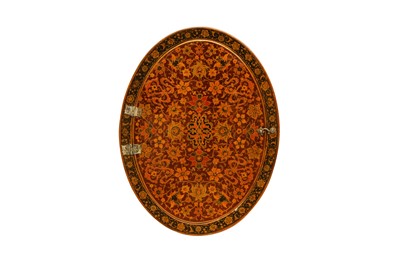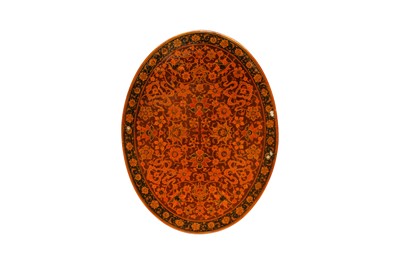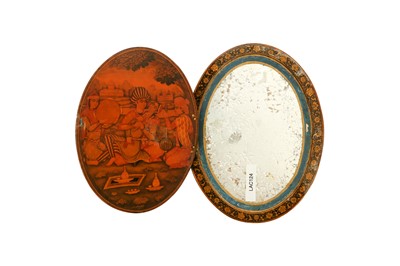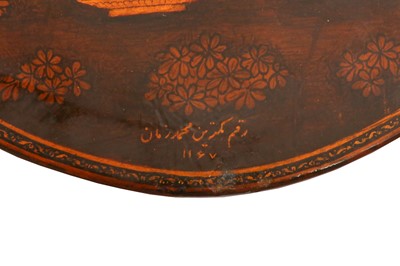28th Apr, 2023 11:00
Islamic Art - Property of a European Collector Part V
AN INDIAN-STYLE LACQUERED PAPIER-MÂCHÉ MIRROR CASE
Post-Safavid Iran, 18th - 19th century
AN INDIAN-STYLE LACQUERED PAPIER-MÂCHÉ MIRROR CASE
Post-Safavid Iran, 18th - 19th century
Of oval shape, polychrome-painted, heightened with gold and lacquered, the front and back decorated with illuminated intricate floral triumphs featuring interlocking rosette and lotus flower trellis, foliage, and sinuous Chinese cloud-bands surrounding a central arabesque medallion with red split palmettes, reminiscent of 19th-century Qajar and Kashmiri lacquered bindings and pen cases, the outer decorative frame with a floral frieze alternating roses and lotuses in gold on a black ground, the reverse of the front cover showcasing an Indian-style garden scene with a young prince embracing a courtly lady, the couple flanked by a female drummer and a male musician playing a kamancheh (a Persian bowed string instrument), in front of them a tray with lavish golden vessels and blue and white porcelain bottles, at the bottom of the garden scene an inscription in gold reading The Work of the Humblest Muhammad Zaman 1167 AH (1753 AD), 21.5cm x 16.5cm.
The combination of dense polychrome-painted vegetal scrollwork, cloud-bands, and arabesque motifs outlined in gold on the front and back of our lot is usually attributed to late Qajar Iranian and North Indian productions. In Iran, the use of gold outlines to illuminate polychrome-painted motifs suffered a constant decrease between the 16th and 18th centuries, and it was only in the 19th century - the Golden Age of the Qajar epoch - that the trend was reversed. Qajar 19th-century lacquered artworks testify to a veritable boom in terms of illumination; the denser, more intricate, and more convoluted the design, the later the production period (N. D. Khalili, B. W. Robinson, and T. Stanley, Lacquer of the Islamic Lands: Part 2, 1997, p. 182 and pp. 195 - 205, especially figs. 421, 423 and 427).
Following this trend, our mirror case should be dated to the mid to late 19th century. Instead, on the reverse of the cover, there is an inscription attributing the work to an artist called Muhammad Zaman, followed by the date 1167 AH (1753 AD). It would not be the first instance in which a Qajar lacquered artifact presents an earlier dating and artist's attribution, often linking the work to the Safavid period. Nevertheless, the mention of Muhammad Zaman, a name both recurrent and puzzling in the world of Persian lacquer, and the fineness of the Indian-style figural garden scene raise some questions. According to several scholars, there are two main Persian painters known by the name of Muhammad Zaman: the first one worked at the court of the Safavid ruler, Shah 'Abbas II (r. 1642 - 1666); the latter started his career towards the end of Karim Khan Zand's leadership (r. 1751 - 1779) and flourished at the court of the second Qajar ruler, Fath 'Ali Shah (r. 1797 - 1834). The date on our mirror case is incompatible with either painter's timelines, leaving us to wonder if this is the work of a third homonymous artist. Further intrigue is sparked by the lack of the takhallos 'Ya Sahib al-Zaman' in our lot, which usually accompanies these painters' works.
Zaman I, also known as Muhammad Zaman ibn Hajji Yusuf, was particularly renowned for his Indian themes and the adoption of European pictorial conventions, which are elegantly showcased in the garden scene on the reverse of our cover. In this composition, the strong and garish shades favoured in late Qajar times are replaced with gentle tones and softer hues, used so sparingly that much of the ground has almost been left uncoloured, matching the pictorial aesthetic spearheaded by 17th-century Safavid painters like Shaykh 'Abbasi, 'Aliquli Jabadar, and Muhammad Zaman (N. D. Khalili, B. W. Robinson, and T. Stanley, Lacquer of the Islamic Lands: Part 1, 1997, pp. 34 - 35).
To conclude, although the inscribed '1753' dating seems incompatible with both the design of heavily illuminated vegetal meanders and arabesque patterns on the mirror case's exterior as well as the lifespan of the Persian artists accounted by the name of Muhammad Zaman, the Indian-style garden scene embraces pictorial qualities typical of late Safavid lacquer production. This suggests this mirror case could have been the work of a third homonymous artist or follower of the first Muhammad Zaman active in the second half of the 18th century, bridging the gap between late Safavid and early Qajar lacquer models.
Sold for £9,375
Includes Buyer's Premium
Do you have an item similar to the item above? If so please click the link below to submit a free online valuation request through our website.




